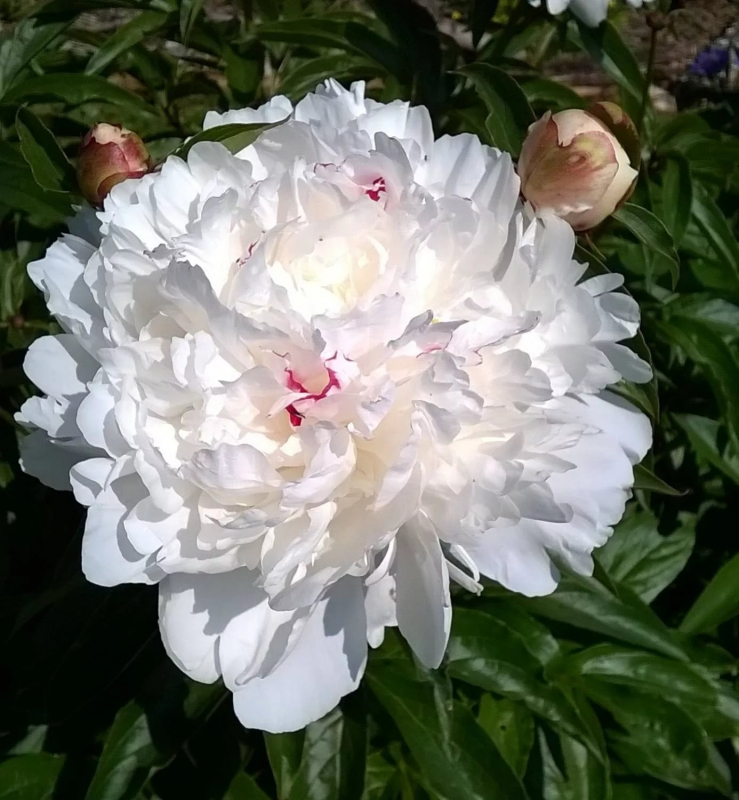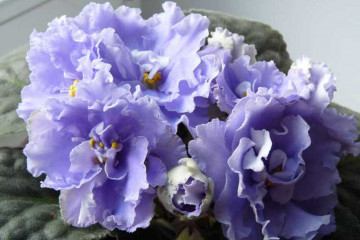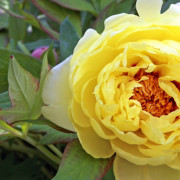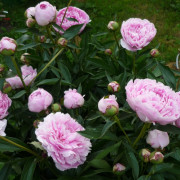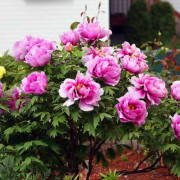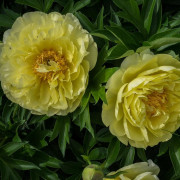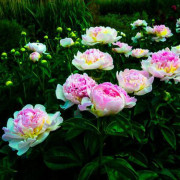White peonies - description and characteristics of the best varieties with a colored center
Content:
- White peonies: short description, characteristics
- Classification of tree peonies and varieties that are in greatest demand among gardeners
- Growing a flower, how to plant it in open ground
- Care for white varieties
- Blooming white peonies
- Peonies after flowering
- Diseases and pests of peonies
One of the most ancient plants is the peony. Pink and white peonies are especially popular. They are often presented as a bouquet at the holidays. They are of great importance in people's lives.
White peonies: short description, characteristics
White peonies are perennials. The height of the flower can be from 30 cm to one and a half meters. They are very popular due to their attractive appearance. Peonies are ideal for decorating your backyard.
White peony varieties belong to the Peony family. They can be herbaceous and shrub types. The roots of these plants go deep into the ground. The bushes are large in size, and their foliage is decorative. The color of the leaves ranges from green to purple. There are species with different inclusions. Peonies have single flowers. Their diameter is 15-25 cm.
Use in landscape design
Some peonies look good in landscape compositions, not only when they bloom, but also during fruiting. They add a special touch to the composition. At this time, the leaflets are bright red. The seeds are inherent in black color. From a distance, they look like flowers and are an ornament during the cold season.
In landscape design, a peony with a yellow center is often used. Also in the flower compositions there is an apple blossom peony, a red herbaceous peony, and a white herbaceous peony.
Classification of tree peonies and varieties that are in greatest demand among gardeners
Gardens are often decorated with tree-like species. There are various varieties of this species.
Herbaceous
At the beginning of this century, about five thousand varieties of herbaceous peonies were registered. They are centenarians. They can grow in one place up to 50 years. At first they are small in size, but then their stems become strong and strong.
White Swan
The variety is derived from the milk-flowered one. Its shape is terry and pinkish. The flower grows up to 18 cm in diameter. It is characterized by a pale pink color.
White iceberg
The flower is large. Its stem is high. The color is white with a cream shade. Leaves are large, dark green. The variety is developing rapidly.
Ballerina
It is a hybrid of the Caucasian flora. The flower has a double shape. It grows in diameter up to 16 cm. The color is greenish-yellow-white. The stem reaches a height of 90 cm.
Victoria
The flower has a terry spherical shape. Diameter 17 cm. The color of the flower is creamy white. When the flower blooms, it has a light yellow highlight. Green leaves are narrow in shape.
Big Boy
The flower is characterized by a simple, narrow shape. It grows up to 15 cm in diameter. The flowers are creamy white, which then turn white. The variety has an early flowering.
Charles White
Terry flowers are spherical. Swirling petals, white with a yellowish tinge. It grows in height up to 90 cm.
White Cap
The variety belongs to Japanese. Diameter up to 15 cm, dark pink color.
Krinkled White
The flower is large, pure white. The petals are wavy. The middle of the flower is made up of yellow stamens. The stems are thin and straight, but firm.
Bowl of Cream
The color of the plant is creamy white. The leaves are long and dark green. The flower is illuminated from hidden rings.
Gladys Hodson
The diameter of the flower is up to 50 cm. The flower is dense, white-cream color. The bush grows to a height of 1 m. The stems are thin and bent. The cultivar blooms late.
Carrara
Carrara has a flower that grows up to 16 cm in diameter. The petals are white. The height of the bush is up to 80 cm.
Adorable
The flower is double, pinkish. Has a pale pink color. There are golden stamens in the center. Diameter about 16 cm.
Alsace Lorraine
A double flower, 17 cm in diameter. Pure white petals with a creamy and fawn tint. The petals are round and cupped.
Lallaby
The height of the flower reaches no more than a meter. The flower reaches 15-16 cm in diameter. The petals are pale pink in color.
Mathers Choice
The flowers are about the size of a dinner plate. The plant is dense with pure white petals. Height reaches 70 cm. Leaves are small in size.
Fastiva Maxima
The plant is distinguished by lush flowering. Flower diameter about 20 cm. Pure white, semi-double shade.
Gold Mine
The petals are yellow and the leaves are yellow-green. The flower is large.
Tree-like
Treelike peonies are luxuriantly characterized by numerous flowers. There are different varieties. They differ in shape and color.
Snow tower
Terry flower. The petals are pink-white at first, and then white with a pinkish tinge. The plant grows to a height of 150 cm.
White phoenix
The shrub grows up to 2 m in height. The leaves are large, bright green. The petals are white. When it blooms, it has a pinkish tint.
White jade
The variety is rare and old. The petals are pure white. The bush grows up to 70 cm.
Maria
Terry flower with white petals. Height up to 70 cm.
Silk veil
The variety is frost-resistant. The flowers are snow-white with a dark purple base.
Hybrid
Hybrid varieties of peonies are perennials that have signs of herbaceous and tree-like groups.
White Imperial
A hybrid with large white flowers. At the base there is a ring of cream-colored stamens.
Cora Louise
A shrub with an interesting name grows under a meter. The stems are blue. The petals are white with a burgundy center.
Going Bananas
The diameter of the flower is 20-22 cm. The petals are yellow. The height of the bush is 60-70 cm.
Singin 'in the rain
The bush is lush and green. Double creamy yellow flowers. Diameter about 20 cm.
Canary Diamonds
Semi-double flower. At first, the petals are white-pink, and then pink-yellow.
Border Charm
Medium-sized plant. Yellow and pale around the edges. Flowers reach 20 cm in diameter.
Yellow Crown
The petals are yellow. Semi-double flower with a diameter of 13 cm.
Growing a flower, how to plant it in open ground
When planting a peony, it is important to follow the rules that will allow you to grow a beautiful flower.
Planting by root cuttings
Root cutting is a small part of the rhizome that has a growth bud and root. Florists often resort to this particular method of planting a peony in the open field.
What time is the boarding
The pieces are harvested after the buds have ripened, but even before small white roots are formed. Cuttings are made in July-August.
Location selection
The landing site should be sunny, protected from drafts. However, there should be a normal supply of air.
How to prepare the soil and flower for planting
The soil should be neutral or slightly alkaline acidity. It should also be light and fertile. Before planting, the rhizome is soaked in a solution of potassium permanganate for a couple of hours.
Landing procedure
Step-by-step planting process:
- Dig out the rhizome and clean it.
- Divide the cuttings so that each of them has a root and a growth bud.
- Cuttings are soaked in a solution of potassium permanganate. Then they are doused in charcoal and left overnight.
- Plant the rhizome pieces at a distance of 15-20 cm from each other.
Correct planting of peonies will ensure abundant and beautiful flowering.
Seed planting
The collected seeds must be planted immediately in the garden. The seeds are deepened by 5 cm. In order for the seeds to germinate faster, exposure to variable temperatures throughout the day is necessary. In the afternoon, 25-30 ℃ above zero. At night +15 ℃.
Care for white varieties
Peonies require careful maintenance. This is the only way to achieve a beautiful flowering of the bush.
Watering and feeding
Peonies need to be watered regularly, especially before flowering, in the first half of June. Watering is also required during bud formation and root growth. This time refers to July and September.
From the third year after planting, it is required to feed the plant. In early spring, they are fed with urea under a bush. The second feeding is carried out during the formation of buds, and then at the beginning of flowering. Fertilize with nitrofoskoy - 1 tsp. on the bush. The fourth time is fed 2 weeks after flowering. Superphosphate and ash are used in 1 tbsp. spoon.
Mulching and loosening
Peonies prefer loose soil. However, loosen must be done carefully. Loosening can be deep at a distance of 10 cm from the bush. In spring it is worth doing mulching with a small amount of rotted manure.
Preventive treatment
The processing is carried out two or three times. The interval between treatments should be 10-12 days. The procedure is based on spraying with a solution of fungicides.
Blooming white peonies
Peonies have different flowering times depending on the variety.
A period of activity and rest
The earliest varieties bloom until June 5th. Early June 5-10. Average - June 15-20. Late June 25-30.
Care during and after flowering
During flowering, abundant watering is required. It is required to thoroughly soak the roots once a week. 3-4 buckets are required per bush. After flowering, it is important to fertilize the plant. You can use an aqueous solution of mullein.
What to do if it does not bloom, possible reasons
Peonies may not bloom for the following reasons: wrong planting place, planting errors, improper care, diseases and pests.
Peonies after flowering
After flowering, proper care for the peonies is very important.
Transfer
A transplant is carried out every five years. It is better to transplant in September. Before transplanting, the stems are cut off. When digging up a bush, they retreat from it by 25 cm. After digging, the rhizome is washed with water and kept in the shade for 2-3 hours.
Pruning
Pruning is carried out two times. After the end of flowering and in the fall.
Preparing for winter
Preparing for winter is pruning and fertilizing. Also, peonies are covered with spruce branches or a layer of mulch.
Diseases and pests of peonies
Among the common diseases of peonies, it is worth highlighting: rust, gray rot, powdery mildew and mosaic of leaves, leaf spot. Rust is fought with Bordeaux fluid. Powdery mildew is removed with soda ash. The mosaic cannot be treated.
Pests of peonies are: ants, aphids, nematodes, bronze. Ants are taken out with repellents. Aphids can be removed with Actellik. Nematodes are not displayed. The bronze is collected by hand.
Peonies are beautiful flowers that are essential for every grower. Proper care is important so that the plant will please with lush flowering.

